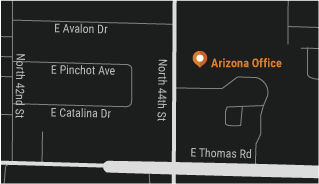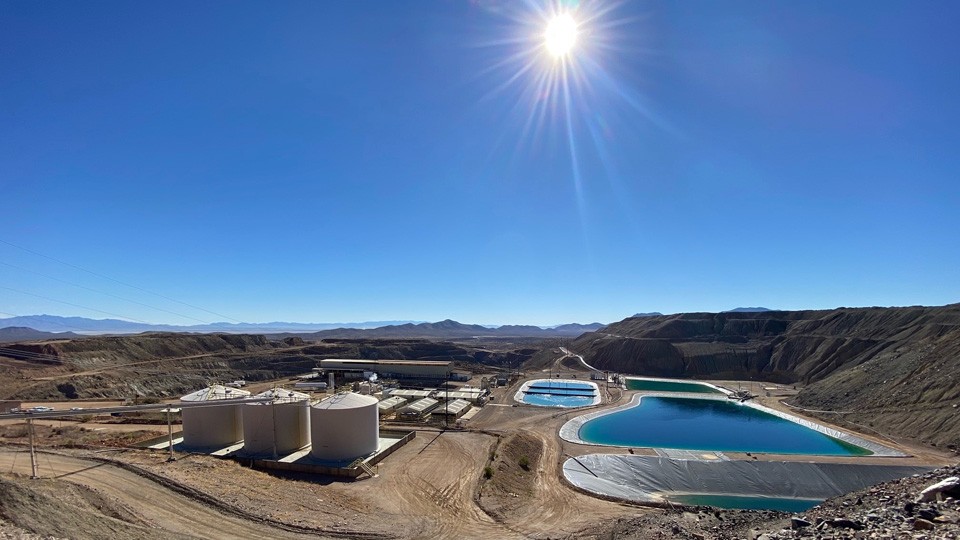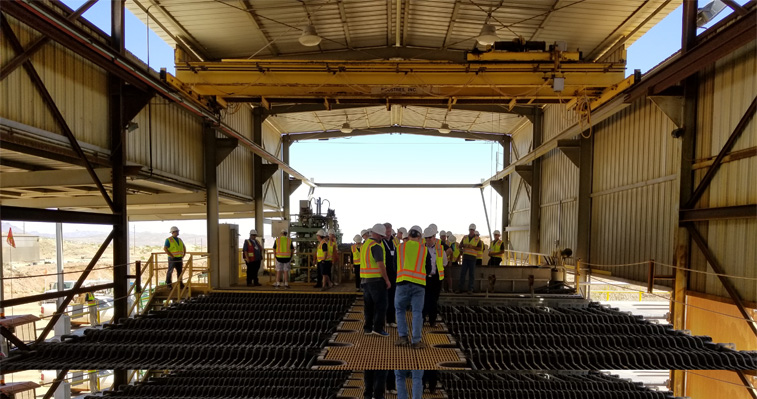GUNNISON PROJECT
The Gunnison Project is located about 65 miles east of Tucson, Arizona on the southeastern flank of the Little Dragoon Mountains in the Cochise Mining District. The property is within the copper porphyry belt of Arizona. The Gunnison Project hosts the Gunnison deposit and contains copper oxide and sulfide mineralization in potentially economic concentrations.
The Company completed a PEA in Q4 2024, outlining an open pit heap leach and SX/EW operation extending over 18 years and producing LME Grade A copper cathodes directly onsite.
PROJECT HIGHLIGHTS
- Private and State land package and 100% ownership in Tier 1 jurisdiction
- Onsite power, rail and water in place
- Simple open pit heap-leach and SXEW operation
- Permitting framework is simple and streamlined with the State
NEXT STEPS
- Metallurgy and infill drilling
- Pre-Feasibility Study
- Definitive Feasibility Study
- Construction Decision
Highlights of the PEA (United States dollars)
- The Gunnison Project, a fully vertically integrated operation producing finished copper cathode on-site in Arizona for domestic U.S. supply chains, has an after-tax net present value (8%) of $1.3 billion and an internal rate of return (IRR) of 20.9% at a long-term copper price of $4.10/lb;
- One of the most substantial open pit copper projects in the U.S. with total Measured and Indicated (“M&I”) Mineral Resources in the open pit of 551 million tons at a total copper grade of 0.35%, capable of supplying 8% of recent annual U.S. domestic copper production[1]
- Simplified and lower risk path to permitting; the Gunnison Project has current operating permits and there is a more streamlined amendment process to State and Local permits to proceed with open pit mining;
- Significant benefits for the community and local economy through the payment of over $840 million in U.S. federal, state, and local taxes, partnerships with local institutions such as Cochise College, and the creation of over 650 local jobs;
- Average annual copper cathode production of 83,700 tons (167 million lbs) over the first 16 years and total production of 1,355,900 tons (2,712 million lbs) over the entire 18 year mine life at an average Cash Cost (C1) of $1.42/lb and Sustaining Cash Cost[1] of $1.94/lb of copper produced;
- Total initial capital cost of $1.3 billion and after-tax payback period for initial capital of 4.1 years;
Environmental advantages include lower water usage per pound of copper produced versus copper concentrate producers, up to 10% reduced energy consumption due to on-site clean energy production, and zero risk of environmental impacts from tailings dam failures as there are no tailings produced.
The PEA is preliminary in nature and includes inferred mineral resources that are considered too speculative geologically to have the economic considerations applied to them that would enable them to be categorized as mineral reserves. There is no certainty that the conclusions reached in the PEA will be realized. Mineral resources that are not mineral reserves do not have demonstrated economic viability.
[1] U.S. Geological Survey, Mineral Commodity Summaries, January 2024
[2] Sustaining Cash Cost = Cash Cost + Sustaining Capex + Deferred Stripping + Royalties
TABLE OF KEY METRICS
| Valuation Metrics (Unlevered) | Unit | 2024 PEA $4.10/lb Cu |
| Net Present Value @ 8% (after-tax) | $ millions | 1,260 |
| Internal Rate of Return (after-tax) | % | 20.9 |
| Payback Period (after-tax) | # years | 4.1 |
| Project Metrics (Imperial unless stated otherwise) |
Unit | 2024 PEA $4.10/lb Cu |
| Construction Period – SXEW plant | # years | 2 |
| Life of Mine (“LoM”) | # years | 18 |
| Strip Ratio | Waste : Feed | 2.06/1 |
| LoM Mineralized Material Mined | ktons | 550,621 |
| LoM Alluvium-Gravel waste | ktons | 759,370 |
| LoM Hard-Rock waste1 | ktons | 375,227 |
| LoM Copper Grade | % CuT | 0.35 |
| LoM Average Annual Crusher Throughput | millions tons | 34.0 |
| LoM Recoveries | % CuT | 69.5 |
| LoM Oxide / Enriched Recoveries2 | % CuTSol | 90.0 |
| LoM Primary Sulfide Recoveries (years 8 to 18) | % CuSu | 60.0 |
| LoM Recovered Copper Cathode | millions lbs | 2,712 |
| Average Annual Copper Production (years 1-16) | millions lbs | 167.3 |
| Average Annual Copper Production (years 1-16) | 000’s tons | 83.7 |
| Initial Capital (including contingency)3 | $ millions | 1,343 |
| Sustaining Capital4 | $ millions | 876 |
| Cash Cost (C1)5 | $/lb Cu | 1.42 |
| Sustaining Cost6 | $/lb Cu | 1.94 |
| Average Annual EBITDA7 | $ millions | 419 |
| Average Annual Free Cash Flow8 | $ millions | 309 |
Notes:
1. Hard rock waste includes 85 million short tons of pure limestone, a highly marketable material.2. Excludes recovery of sulfides from conventional leaching. Some sulfides are expected to leach and provide up-side to recoveries and copper production.
3. Includes acid plant, leach pad, SX-EW, crushing facility, truck shop, mining pre-strip, highway move, owners’ costs and other minor infrastructure.
4. Sustaining Capital includes $346 million in deferred stripping costs
5. Cash Cost includes mine operating, crushing and leaching, process plant operating, and general and administrative costs (“G&A”).
6. Sustaining Cost includes Cash Cost, Sustaining Capex, Deferred Stripping, and Royalties.
7. EBITDA = Revenue – Cash Operating Expenses; Average annual of Y1 to Y16; Revenue includes sales of copper to U.S. based customers at Spot Price and sales of copper to Triple Flag at Stream Fixed Price (25% of spot)
8. Free Cash Flow = Operating Cash Flow (After Tax) – Capital Expenditures; Average annual of Y1 to Y16
Preliminary Economic Assessment Summary
The Project is in Cochise County, Arizona, approximately 65 miles east of Tucson and is held or controlled 100% by GCC. The Gunnison deposit of the Gunnison Project was previously designed and developed as an in-situ recovery (“ISR”) copper operation. High copper prices, the advancement of sulfide leaching technologies, and the greater overall copper extraction afforded by open pit mining and heap leaching has prompted GCC to focus on the open pit alternative to ISR. Nevertheless, the optionality on the fully permitted ISR operations and well stimulation remains an asset to the Company and this optionality will be maintained. This includes maintaining full compliance with all regulatory and permit requirements including maintaining hydraulic control, pumping, monitoring and regulatory reporting.
The Gunnison Open Pit PEA plans to pre-strip alluvial overburden using leased owner-operated equipment. The deposit is a single large body allowing for more cost effective haulage costs, versus mining from numerous regional deposits. A primary gyratory crusher will be installed to crush to a P80 of 6 inches for leaching predominately oxide mineralized materials on the leach pad. A rail spur from the Union Pacific Southern Pacific (UPSP) will provide straightforward access and inexpensive transportation for incoming sulfur and outgoing copper cathodes. The sulfuric acid plant will produce acid with a net cost of approximately $36 a ton and 27 MW of clean energy.
GCC has a successful track record of permitting and community relations. This, along with the fact that the Gunnison open pit has no federal permitting nexus, on flat ground with no identified endangered or threatened species or habitat, and no historical, archaeological, or Native American artefacts, indicates the Company’s prior permitting track record can be maintained.
Figure 1 shows the stacked total mining profile of waste and process feed. Overall strip ratio is 2:1, however 67% of the waste is alluvium gravel which has the advantage of lower mining costs. The equivalent strip ratio based on hard rock costs is approximately 1.57:1.

Figure 2 shows the LoM stacked annual copper production by conventional oxide leaching compared to sulfide leaching. Sulfide leaching makes up only 14% of the total LoM copper production and does commence until year 8 of operations.

Mine production schedule
| Year | Mined Tons mtons | Head Grade | Recovered Copper | ||||
| Total Moved | Mined Material | Alluvium Waste | Hardrock Waste | % TCu | ktons | mlbs | |
| -2 | 95.0 | 95.0 | |||||
| -1 | 95.0 | 1.5 | 93.4 | 0.1 | 0.37 | 3.46 | 6.9 |
| 1 | 95.0 | 22.9 | 71.2 | 0.9 | 0.50 | 74.66 | 149.3 |
| 2 | 100.0 | 31.1 | 54.0 | 14.9 | 0.41 | 83.30 | 166.6 |
| 3 | 100.0 | 23.9 | 73.1 | 3.0 | 0.52 | 87.17 | 174.3 |
| 4 | 100.0 | 30.1 | 63.5 | 6.5 | 0.43 | 87.51 | 175.0 |
| 5 | 100.0 | 31.0 | 60.9 | 8.1 | 0.38 | 87.49 | 175.0 |
| 6 | 105.0 | 37.7 | 32.1 | 35.1 | 0.34 | 87.63 | 175.3 |
| 7 | 120.0 | 33.7 | 77.5 | 8.7 | 0.37 | 87.25 | 174.5 |
| 8 | 120.0 | 39.6 | 28.0 | 52.4 | 0.31 | 87.28 | 174.6 |
| 9 | 120.0 | 33.8 | 65.3 | 20.8 | 0.37 | 87.23 | 174.5 |
| 10 | 120.0 | 36.7 | 41.1 | 42.1 | 0.34 | 86.91 | 173.8 |
| 11 | 120.0 | 41.0 | 4.1 | 74.9 | 0.30 | 84.48 | 169.0 |
| 12 | 120.0 | 41.6 | 78.4 | 0.26 | 73.91 | 147.8 | |
| 13 | 62.2 | 40.4 | 21.8 | 0.33 | 85.86 | 171.7 | |
| 14 | 42.0 | 38.7 | 3.3 | 0.33 | 86.11 | 172.2 | |
| 15 | 36.2 | 35.0 | 1.2 | 0.35 | 85.06 | 170.1 | |
| 16 | 34.8 | 31.9 | 2.9 | 0.29 | 65.96 | 131.9 | |
| 17 | 11.36 | 22.7 | |||||
| 18 | 3.23 | 6.5 | |||||
3D View of Gunnison Project Infrastructure

FINANCIAL ANALYSIS
The PEA base case generates an after-tax NPV of approximately $1,260 million (at a cash flow discount of 8%) and an IRR of 20.9%.
The base case uses the following parameters over the 18-years of production:
- Copper selling price of $4.10/lb
- Total copper recovery of approximately 69%;
- LoM average of approximately 10.6 pounds of acid consumed for every pound of copper produced;
- Acid plant construction in year -1 with a price of sulfur of $110 per short ton delivered and a price of acid produced on site of 36 $/ton including power co-generation credits.
- Acid buying price of $150/ton for the few occasions acid is required above the acid plants capacity and an acid selling price of $130/ton if excess acid is produced in any year.
- Combined state and federal tax rate of [25.9]%;
Table of Capital Costs
The capital cost estimates for this PEA, shown in table below, were developed with a -25% to +30% accuracy. The Company has used an overall contingency of 20% in accordance with Association of the Advancement of Cost Engineering International (AACE) Class 5 estimate guidelines.
Total initial (pre-breakthrough) capital expenditures (including 20% contingency, EPCM, capital spares, owner’s costs, mobile equipment and freight) are estimated at $1,343 million for initial production of copper cathode. Mine costs includes pre-stripping and capitalized pre-operating mobile fleet lease costs. Total sustaining capital costs over the life of the mine are $876 million, which includes deferred stripping, leach pad expansion and mining equipment.
Facilities at the mine site will include one open pit, two waste stockpiles, primary crushing plant and conveying system, heap leach pad, Solvent Extraction-Electrowinning (SX-EW) process plant, sulfur burning sulfuric acid plant with cogeneration capability, technical and operational support offices, mine truck shop and maintenance buildings, refueling systems, electrical substation and distribution, water supply and distribution, warehousing and Union Pacific rail spur.
Table of Operating Costs
Mining operating cost estimates, prepared by Independent Mining Consultants (IMC), are based on an owner’s team managing mining activities, using an owner-operator model. Process operating cost estimates and G&A cost estimates were prepared by M3, as summarized in the table above (note numbers may not add due to rounding). Sequencing of operations and annual cash flows are detailed in Exhibit 1 and 2, at the end of this news release.
The operating site includes numerous infrastructure and location advantages including:
- Union Pacific rail line right next to the property with a 2 km rail spur envisioned.
- High voltage power lines with clean power from SSVEC.
- Close to local and regional labor pools of Benson, Willcox, and Tucson.
- Flat land conducive for development.
- Deposit is within an enclosed basin; therefore no 404 permit is required.
- No endangered flora or fauna on the property.
Table of Profitability Metrics
Table of Sensitivities
DCF Model Annual Cash Flows ($ millions)
Opportunities
Several opportunities have been identified which could enhance the viability and economic attractiveness of the Open Pit Project. Many of these opportunities may be realized by removal of risk and uncertainty that are present at the PEA level.
- Acid Consumption. Mineralized material sorting is a significant value-add opportunity for the Gunnison open pit. Greater than 80% of the mined copper is oxide mineralization, forming visually distinct blue-green and red-brown zones that are ideally suited to optical mineralized material sorting. Preliminary data suggest sorting of this material has the potential to greatly reduce acid consumption and volume of material leached by removing 40 to 50 percent of the process stream as unmineralized, higher acid consuming, waste. This would result in significant savings on operating costs.
- Pit Slope Angles. The pit wall angles for the Gunnison open pit are considered reasonable based on the data available, however it is conceivable that pre-feasibility geotechnical data can steepen the pit walls in the gravel-alluvium, thus reducing pre-strip capital costs and life of mine waste mining costs.
- Copper Recoveries. The anticipated copper recovery is an estimate based on the best interpretation of existing test work. This copper recovery could be exceeded in practice. Recovery increases could improve the rate of recovery, as well as increase total copper recovered. Improvements in the rate of recovery would mean lower flows from the leach pad for the same level of copper production, lowering operational costs., Or, the increased grade could result in higher copper production (revenue) for the same operating cost. Improvements in total copper recovered have the obvious benefit of increasing total revenue during the life of the mine.
- Increased Copper Price. The current financial analysis is based on an average, long-term copper price of $4.10 per pound based on current consensus pricing. Current spot markets are currently 5% to 10% higher than long-term pricing estimates. Global demand increases for copper have the potential to drive copper prices higher, thereby increasing the economic (revenue) outlook for the Project.
- Strong and Harris Copper-Zinc-Silver Project. The Company filed a separate technical report dated October 20, 2021, on the Strong and Harris Copper-Zinc-Silver Project titled “Estimated Mineral Resources and Preliminary Economic Analysis, Strong and Harris Copper-Zinc-Silver Project, Cochise County, Arizona” (the “S&H PEA”). At present, the S&H PEA contemplates development of the project on a standalone basis with its own infrastructure. JCM is also now being developed on a standalone basis in collaboration with Nuton, LLC, without sharing infrastructure with Gunnison. However, with the potential development of an open pit at Gunnison, the opportunity for shared infrastructure, capital, and operating costs with the Strong and Harris open pit is significant and may form the basis for future technical reports integrating all deposits: Gunnison, Strong and Harris and Johnson Camp Mine.
- Gravel Revenue. 759 million tons of alluvial gravel is expected to be mine during the mine life. Gravel as an aggregate or rock product is a potential source of revenue. The planned rail spur and railyard provides the Company with access to larger markets for the sale of construction aggregates. Presently, the sale of construction aggregates, is not included in the financial analysis presented in this report. However, if just 10% of this material could be sold for a net cost of $5/ton, it could potentially add $380M in revenue to the Project. This does not include the costs of making this material marketable, and there is no guarantee it can me made marketable.
- Limestone Revenue. Similar to construction aggregates, 85 million tons of clean limestone waste will be produced from the mining operations at Gunnison. Crushed limestone is highly valuable commodity in cement, aggregate, chemical and agricultural industries, selling for between $10/ton and over $60/ton in the region. Previously, the Johnson Camp-Gunnison area has been investigated as a source of limestone. With the rail spur and railyard, this material could be transported by rail to several regional markets. If 50% of this limestone waste could be sold at $20/ton it could generate approximately $850M in additional gross revenue. This does not include the costs of making this material marketable, and there is no guarantee it can me made marketable.
- Alluvium Mining. 67% of the waste mined in the pit is weakly cemented gravel (alluvium). The current design includes 40% drill and blast for this gravel however it is possible much of this material will not need any drill and blast. This will be investigated during the planned pre-feasibility study (“PFS”).
- Alternative Mining of Alluvium. The current removal of alluvium envisions the use of blast-haul operations. There are potential cost savings by developing other means of removal such as use of conveyors, dozers, or earth movers instead of blast-load-dump equipment. These will be investigated during the PFS”.
- In-pit Leaching. In-pit leaching provides an opportunity to reduce operating costs and improve leach recovery over the life of mined mineralized material. The nature of the Gunnison deposit and aquifer would allow control of leach solutions. Permitting of in-pit leaching would be required through Arizona Department of Environmental Quality, though it is currently being employed at other properties in Arizona. Production sequencing will utilize in-pit leaching as a trade-off to the construction and maintenance of a heap leach pad during PFS work on the Gunnison open pit.
- Exploration Potential. The mining district that GCC has consolidated in recent years exhibits significant exploration potential. Modern exploration activity has not occurred in the district. District-wide data consolidation and integration should be conducted to evaluate its overall mineral potential and identify exploration targets. Exploration for the source of the porphyry copper sulfide mineralization at Gunnison has never been conclusively conducted and copper skarn deposits such as Gunnison are often associated with large nearby porphyry copper deposits. Several historic carbonate replacement deposits including the Republic and Moore deposits merit additional exploration attention. Significant areas of Earp Formation, Colina Limestone and Horquilla Limestone are under cover and have not been explored. These same formations host the mineralization in the Hermosa-Taylor deposits being developed by South 32 in southern Arizona.
The Gunnison deposit is ideally suited to optical mineralized material sorting.
The oxide copper mineralization makes up over 80% of the tons mined. The mineralization is on fracture surfaces and will be exposed on surfaces during the crushing process.
Between these mineralized zones are off white colored marbles that are high in acid consumption but contain little to no copper.
Test work using an optical mineralized material sorter on Gunnison material has shown effective separation of the mineralized colors from the non-mineralized colors. The waste typically has 5 to 10 times the acid consumption as the mineralized material.
The removal of internal waste, will result in lower acid consumption and lower capital costs due to a smaller leach pad and acid plant.
Mineral Resource Estimate
The mineral resource estimate for the Gunnison Deposit is based on results from 122 drill holes totalling 158,785 feet and is effective as of September 4th, 2024. Gunnison deposit mineral resources are classified in order of increasing geological confidence into Inferred, Indicated, and Measured categories in accordance with the “CIM Definition Standards – For Mineral Resources and Mineral Reserves” and therefore Canadian National Instrument 43-101. GCC is not aware of any environmental, permitting, legal, title, taxation, socio-political, marketing or other issues which may materially affect its estimate of mineral resources.
The Gunnison deposit mineral resources are reported within an optimized pit at cut-offs that are reasonable given anticipated open-pit mining methods, processing costs, and economic conditions, which fulfills regulatory requirements that a mineral resource exists in such form, grade or quality and quantity that there are reasonable prospects for eventual economic extraction.
The pit-constrained mineral resources are tabulated using an internal cut-off grade of 0.05% TCu.
No mineral resources were estimated within overburden (Tertiary/Quaternary alluvium), and the reported mineral resources are restricted to lands controlled by GCC.
| Total Resources | |||
| Resource Class | Short Tons (millions) | Total Cu (%) | Cu Pounds (millions) |
| Measured | 191.3 | 0.37 | 1,420 |
| Indicated | 640.2 | 0.29 | 3,684 |
| Measured + Indicated | 831.6 | 0.31 | 5,104 |
| Inferred | 79.6 | 0.20 | 325 |
Notes:
- Mineral Resources that are not Mineral Reserves do not have demonstrated economic viability.
- Mineral Resources are reported at a 0.05% total copper cut-off grade within an optimized pit.
- Rounding as required by reporting guidelines, may result in apparent discrepancies between tons, grade, and contained metal content.
- The Effective Date of the Mineral Resource estimate is September 4, 2024.
The Gunnison mineral resources were modeled to reflect the detailed lithologic, structural, and oxidation modeling completed by GCC. Copper mineral domains guided by these geological controls, were interpreted on east-west vertical cross sections on 100-foot spacing, which encompass the 2.3-mile north-south and 1.3-mile east-west extents of the deposit. These domains were then used to explicitly constrain the estimation of copper grades into 50 x 100 x 25-foot (x, y, z) model blocks using 20-foot composites and inverse-distance interpolation. The grade estimation is further controlled by the incorporation of search ellipses that reflect the orientations of modeled structural zones, as well as those of favorable stratigraphic units in areas unaffected by the structures. Sequential copper assay ratios were used to define three-dimensional surfaces separating the Oxide, Transitional, and Sulfide zones of the mineralization.
All samples were prepared from manually split half-core sections on-site in Arizona. Split drill core samples were then sent to Skyline Assayers & Laboratories (“Skyline”) in Tucson, Arizona, an independent laboratory, for Total Copper (TCu) and Sequential Copper analyses, Acid Soluble Copper (ASCU) and Cyanide Soluble Cu (CNCu). Skyline is accredited with international standard ISO/IEC 17025:2005 General Requirements for the Competence of Testing and Calibration Laboratories. Analytical results for (TCu), (ASCu), and (CNCu) were reported. GCC has no relationship with Skyline Labs other than Skyline being a service provider. Standards, blanks, and duplicate assays are included at regular intervals in each sample batch submitted from the field as part of an ongoing Quality Assurance/Quality Control Program.
Mr. Jeffrey Bickel, C.P.G., with the independent firm RESPEC Company LLC (“RESPEC”) of Reno, Nevada, is a Qualified Person as defined by NI 43-101 and is responsible for this mineral resource estimate. He has verified, reviewed, and approved the technical disclosure contained in this section of the news release. Mr. Bickel has verified the data underlying the results by reviewing the drilling, sampling, assay, and quality assurance and quality control data, as well as the geologic interpretations completed by GCC. Mineral resources that are not mineral reserves do not have demonstrated economic viability. As the Company has completely rescoped the operation from ISR to open pit using a PEA, the prior mineral reserve estimate on the Gunnison Project is no longer current and should be disregarded.
Recommendations
Based on the results of this PEA, it is recommended that GCC consider proceeding with a PFS of the open pit project which is expected to take approximately 18 months. A feasibility study will be proposed on successful completion of the PFS.
Additional drilling for resource verification and geotechnical coverage is recommended to support mine planning. Updating the acid plant design for the selected capacity is also recommended. Additional planning and costing work are required to establish the schedule and costs for the relocation of Interstate 10 and the addition of the rail spur to the Union Pacific Railroad.
Additional drilling will be required for metallurgical studies. Pilot metallurgical heap leach testing is recommended to investigate the recovery kinetics and flow characteristics for the heap leach design. In addition, mineralized material sorting studies are recommended to determine the effectiveness and economics.
A mine plan, heap leach design, SX-EW design and highway move design are necessary to complete the PFS.
GCC has proposed a list and budget for additional work that will support a Prefeasibility Study (PFS).
Ownership, Social License and Permitting
The Project is in Cochise County, Arizona, approximately 65 miles east of Tucson and is held or controlled 100% by GCC through its wholly owned subsidiary Excelsior Mining Arizona, Inc. (GCAZ).
The project is comprised of 9,756 acres including freehold land, state mineral claims and permits and BLM unpatented mining claims and excludes the Johnson Camp and Strong and Harris projects. There is no federal nexus for permitting the project and all permitting is limited to State of Arizona-required permits including the Aquifer Protection Permit, Industrial Air permits and the Mined Land Reclamation Permit.
GCC has a well-developed community engagement plan that has been implemented through numerous public meetings and outreach programs. The Company intends to maintain this approach by continuing to engage with, and meet and discuss its projects with, the local and regional communities and stakeholders.
The Cochise Mining district has legacy mining assets and is a combination brownfields/greenfield site. The Company anticipates the Project will create decades of high paying jobs that will benefit the local communities and the state.
Prior Operations
The Gunnison Project was previously designed as a copper in-situ recovery (“ISR”) mine using solvent extraction-electrowinning (“SX-EW”) to produce copper cathode. The ISR operation commenced ramp-up to production in 2020; however, as previously disclosed, it had operational issues related to low flow rates, so the Company began evaluating alternatives and opportunities to fix the ramp-up challenges. Well stimulation (small scale, shallow level, hydraulic fracking), has the potential to fundamentally change the performance of the wellfield and fix many of the low productivity issues. The Company has obtained a permit for well stimulation and the next step would be to conduct field trials. If well stimulation is successful, it could provide an operation with superior economics to the open pit operation and be in copper production much quicker than an open pit. However, due to the technical risks of ISR and substantially improved viability of the open pit operation, GCC intends to focus the PFS on an open pit operation as the alternative to ISR. If future financing is available for ISR activities, the Company may elect to conduct well stimulation field trials, but such field trials will not hinder the open pit studies. The Company intends to maintain the optionality of future ISR operations and well stimulation trials as this remains an asset to the Company. This includes maintaining full compliance with all regulatory and permit requirements, including maintaining hydraulic control, pumping, monitoring and regulatory reporting.
GEOLOGICAL SETTING AND MINERALIZATION
The Gunnison Project is situated in the Mexican Highland section of the Basin and Range physiographic province. The province is characterized by fault-bounded mountains, typically with large igneous intrusives at their cores, separated by deep basins filled with Tertiary and Quaternary gravels.
The Gunnison Project lies on the eastern edge of the Little Dragoon Mountains. The ages of the rocks range from 1.4-billion-year-old Pinal Group schists to recent Holocene sediments. The southern portion of the Little Dragoon Mountains consists predominately of the Tertiary Texas Canyon Quartz Monzonite whereas the Pinal Group schists and the Paleozoic sediments that host the regional copper mineralization dominate the northern half.
Copper sulfide mineralization has formed preferentially in the proximal (higher metamorphic grade) skarn facies, particularly along stratigraphic units such as the Abrigo and Martin Formations near the contact with the quartz monzonite and within structurally complex zones. Primary mineralization occurs as stringers and veinlets of chalcopyrite and bornite. Primary (unoxidized) mineralization remains “open” (undetermined limits) at depth and to the north, south, and east.
Oxidation of the mineralization occurs to a depth of approximately 1,600 feet, resulting in the formation of dominantly chrysocolla and tenorite with minor copper oxides and secondary chalcocite. The bulk of the copper oxide mineralization occurs as chrysocolla, which has formed as coatings on rock fractures and as vein fill. The remainder of the oxide mineralization occurs as replacement patches and disseminations.
The mineralization at Gunnison is thick and high grade with grades to over 0.8% Cu over nearly 600 feet. The mineralization is consistent and is about 2 miles long, half a mile wide and over 1000 feet thick. The alluvium over the top of the deposit is cheap to mine, requiring little to no blasting.
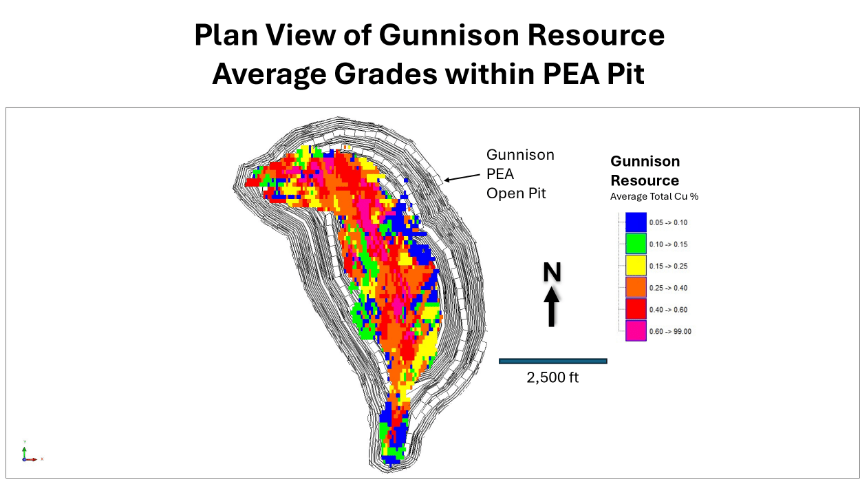
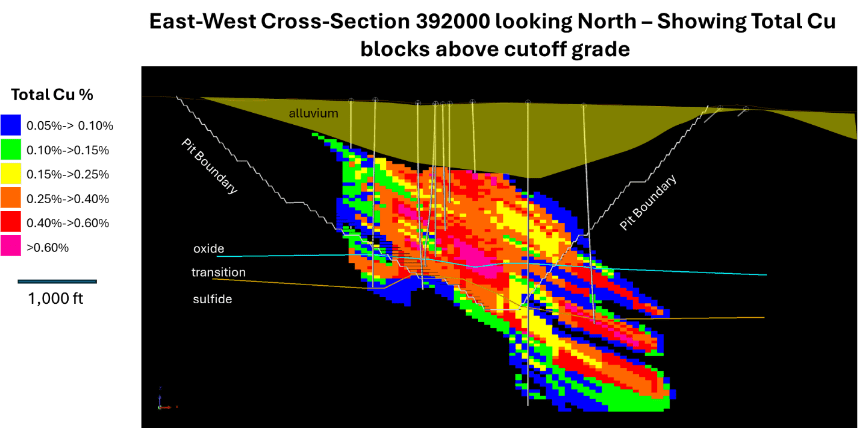
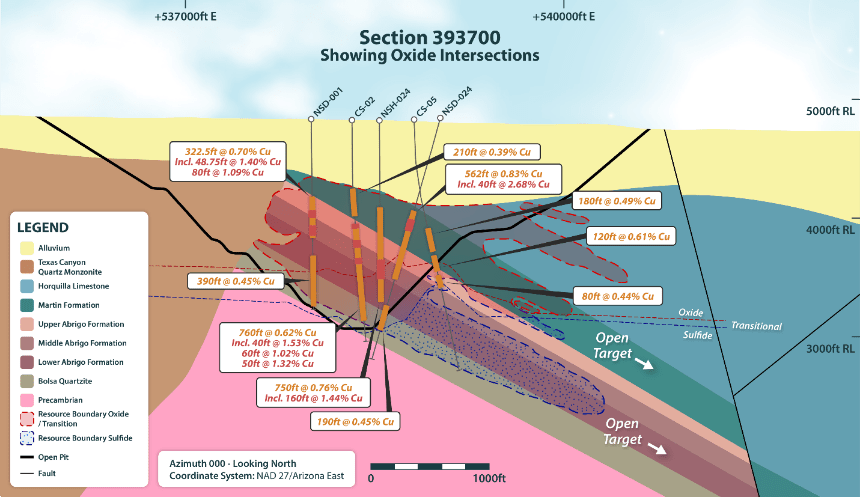
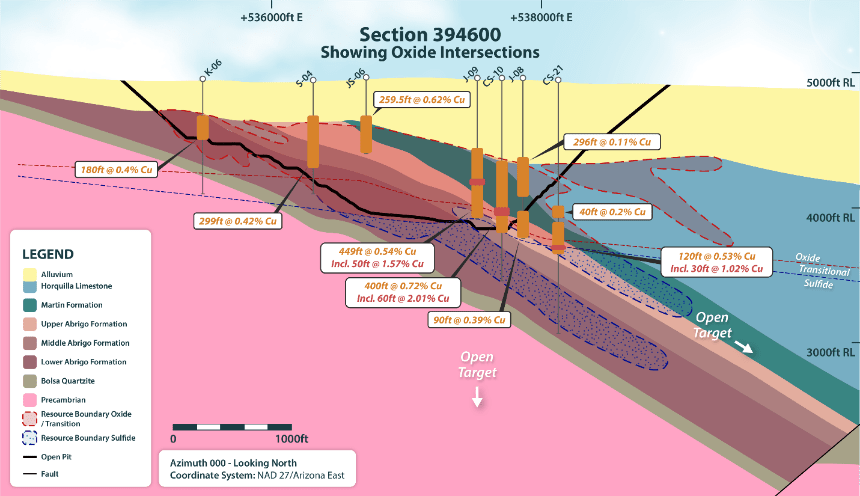
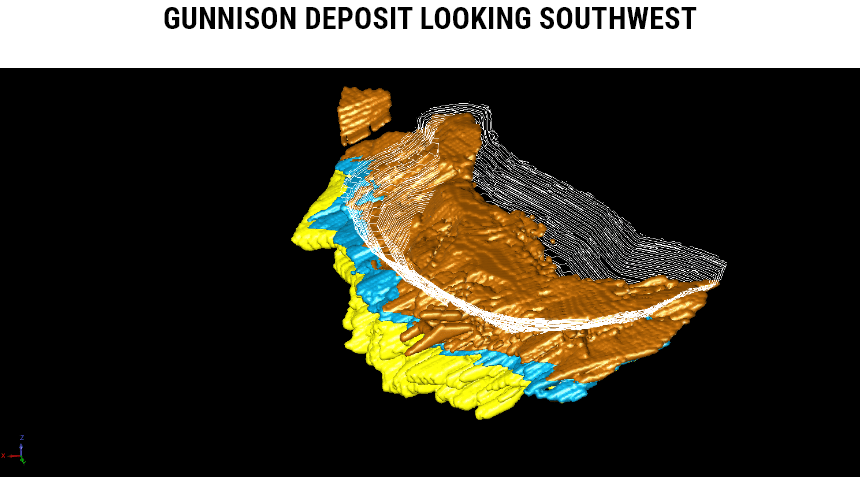
For additional information on the Gunnison Project please refer to the press release dated November 14, 2024 and the Technical Report entitled “Gunnison Copper Project NI 43-101 Technical Report Open Pit Preliminary Economic Assessment”, with the effective date of November 1st, 2024 (the “Report”), each that has been or will be filed on sedarplus.ca.
The Report will be filed on SEDAR+ and on GCC’s website within 45 days of the date of this news release. The Report will consist of a summary of the PEA. The Report is being prepared under the supervision of John Woodson, PE, SME-RM, of M3 Engineering & Technology Corporation, Tucson, Arizona, who is a Qualified Person that is independent of the Company. The Report will also receive contributions from the following additional Qualified Persons, who are also independent of the Company:
- Mr. John Woodson, of M3 Engineering & Technology Corporation, Tucson, Arizona ((capital and operating costs, and economic analysis).
- Mr. Jeffrey Bickel of RESPEC of Reno, Nevada (geology and mineral resource).
- Mr. Jacob Richey, of IMC of Tucson, Arizona (mining methods).
- Mr. Tom Ryan, of CNI of Tucson, Arizona (pit slope angles)
- Dr. Terence P. McNulty of T.P. McNulty & Associates of Tucson, Arizona (metallurgy).
- Dr. Abyl Sydykov of M3 Engineering & Technology Corporation, Tucson, Arizona (mineral recovery)
- Mr. R. Douglas Bartlett, of Clear Creek and Associates of Phoenix, Arizona (hydrology, mining method, permitting and environment).


